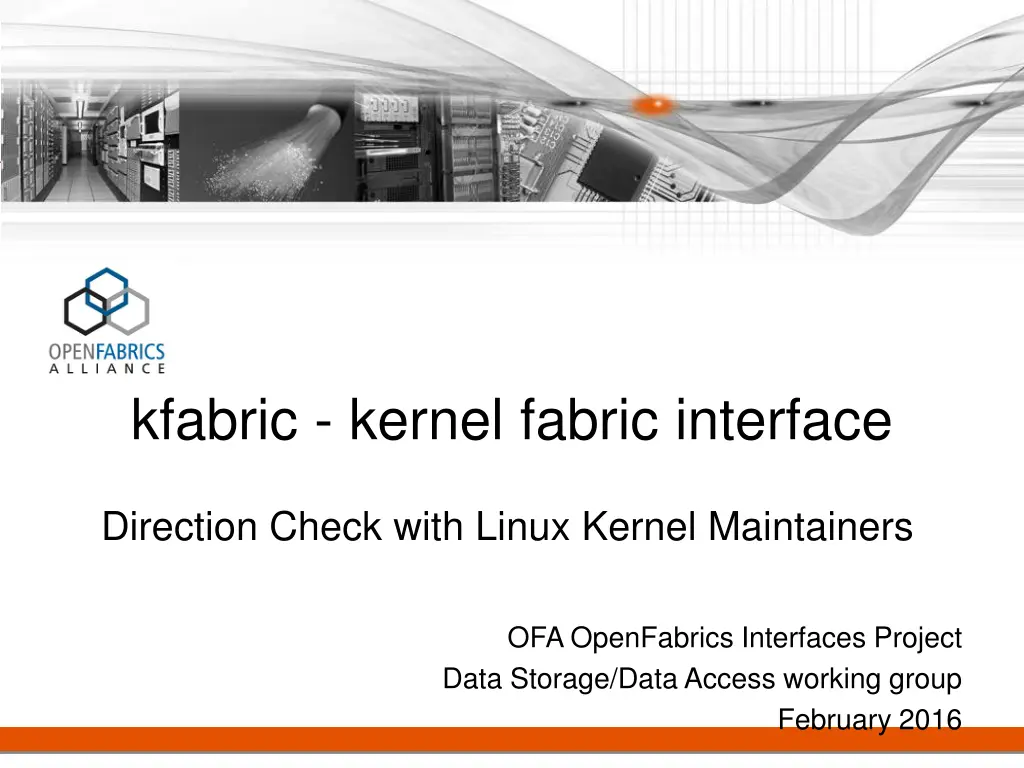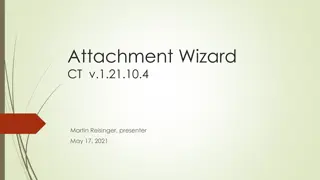
Kernel Fabric Interface for Enhanced Data Access in Linux Ecosystem
"Explore the innovative Kfabric kernel fabric interface developed to enable efficient storage, I/O, and memory access in conjunction with emerging network technologies while maintaining compatibility with existing networks."
Download Presentation

Please find below an Image/Link to download the presentation.
The content on the website is provided AS IS for your information and personal use only. It may not be sold, licensed, or shared on other websites without obtaining consent from the author. If you encounter any issues during the download, it is possible that the publisher has removed the file from their server.
You are allowed to download the files provided on this website for personal or commercial use, subject to the condition that they are used lawfully. All files are the property of their respective owners.
The content on the website is provided AS IS for your information and personal use only. It may not be sold, licensed, or shared on other websites without obtaining consent from the author.
E N D
Presentation Transcript
kfabric - kernel fabric interface Direction Check with Linux Kernel Maintainers OFA OpenFabrics Interfaces Project Data Storage/Data Access working group February 2016
Objective (today) Describe what we re trying to accomplish, and its rationale Describe the approach being taken Ask for your feedback/direction check - Is this an acceptable direction that merits further development? 2 www.openfabrics.org
kfabric objectives Develop APIs to support kernel-based storage and remote data access filesystems, object I/O, block storage, persistent memory (emerging) Network agnostic new network types should not require emulating an existing one device drivers are typically based on a specific network technology Present a consumer-oriented network abstraction Support for emerging use cases - NVM NVM for storage and for memory access see upcoming slide Support for emerging fabrics Allow for innovation with new networks as they emerge Support for existing networks Must run over existing network technologies 3 www.openfabrics.org
What we are proposing Kfabric: an abstract, kernel mode API for I/O Abstract : the API is expressed in terms of I/O operations, not network protocols e.g. read file , write file vs post send request Requirements driven by emerging technologies New/emerging networks require a transport neutral, RMA-enabled API NVM devices and how they will be used Demand exists for an abstract, message passing API based on RDMA 4 www.openfabrics.org
Why a new kernel API? Reliable sockets is a byte streaming interface semantics don t map well to messaging operations kfabric complements sockets by providing a reliable message service Kverbs is a low level device driver tied to the architecture of the underlying wire not suitable for some emerging fabrics kfabric is expected to call kverbs for certain networks The semantics desired by current and emerging storage applications are not well addressed by current APIs 5 www.openfabrics.org
Storage protocols Block and object storage protocols do not map well to sockets Reliable sockets are stream-oriented and require message markers Datagram sockets map well to messages but at the expense of reliability Sockets requires implicit buffering at the sender and receiver, which adds latency, increases CPU utilization, and reduces throughput Socket s completion semantics guarantee only that the data is buffered locally; there is no notion of reliable delivery Sockets does not provide mechanisms for one-sided access (RMA) requires an active software agent on both the sender and receiver. Socket connections don t allow multiple thread access without external synchronization e.g. a mutex to ensure single thread access to partial messages and to avoid losing markers 6 www.openfabrics.org
Storage protocols Block and object storage protocols map well to reliable, message-based APIs that provide RMA services kfabric provides reliable and unreliable message services processes do not need to maintain message markers kfabric does not require implicit buffering kfabric completion semantics are a semantic match with storage reqmts e.g. local completions, remote completions, ordered and out-of-order delivery kfabric endpoints are (selectably) thread-safe multiple threads can progress them independently serialization can be done by the provider, not by the application kfabric provides one-sided semantics enabling direct hardware access without CPU intervention 7 www.openfabrics.org
Emerging storage protocols Present day storage protocols are usually asynchronous and based on a server push model for reads and a server pull model for writes Byte-addressable NVM is likely to introduce a synchronous, client driven model Implies a greater reliance on one-sided operations, which requires richer completion semantics e.g. remote completions, completions based on data placement 8 www.openfabrics.org
Emerging technology - NVM Data replication is the main storage use case when it comes to RDMA with NVM Writing multiple copies of client data to multiple nodes All writes must reach durability point before signaling completion. Fabrics are not just limited to traditional Ethernet or IB Devices are not just limited to traditional RNIC or HCA We need a framework to support Diverse providers w/o requiring emulating existing one. Richer completion semantics Multicast RDMA 9 www.openfabrics.org
Positioning kfabric in the kernel We believe that kfabric is best positioned as a peer to the kernel TCP sockets stack Rationale message orientation complements socket s reliable stream orientation adds support for one-sided (RMA) operations adds support for asynchronous operations rich set of completion semantics is a good semantic match to storage application usage models 10 www.openfabrics.org
kfabric, libfabric relationship kfabric is: kernel modules for storage and remote data access is not: the kernel component of libfabric libfabric a user-mode library for distributed and parallel computing may be leveraged for user mode storage or data access (tbd) libfabric access to kernel services are performed by the provider(s) using the provider s kernel drivers kfabric complements libfabric by filling out the OFI suite of APIs 11
Support for NVM www.openfabrics.org 12
I/O stack including kfabric (similar diagram for user mode using libfabric) kernel application VFS / Block Layer byte access VFS / Block-based FS / Network FS byte access ulp* ulp* ulp* SCSI NVMe iSCSI SRP, iSER, NFSoRDMA, NVMe/F kfabric* sockets kfabric* kverbs provider provider mem bus PCIe HBA NVM NVM NIC HCA NIC, RNIC arbitrary fabric NVM IP IB RoCE, iWarp fabric local block I/O local byte-addressable remote block/file I/O remote byte-addressable ulp* = expected future ULPs, kfabric* is intended as a single API regardless of local or remote and regardless of the wire. www.openfabrics.org 13
kfabric architecture www.openfabrics.org 14
kfabric Framework Kfabric API kfabric API Kfabric Providers Sockets Provider Verbs Provider New Providers** Kernel Sockets kernel Verbs Device Drivers iWarp InfiniBand RoCE NIC New Devices Red = new kernel components, ** = e.g. NVM
kfabric API the details kfabric interfaces form a cohesive set and not simply a union of disjoint interfaces. The interfaces are logically divided into two groups: control interfaces: operations that provide access to local communication resources. communication interfaces expose particular models of communication and fabric functionality, such as message queues, remote memory access, and atomic operations. Communication operations are associated with fabric endpoints. kfabric applications typically use control interfaces to discover local capabilities and allocate resources. They then allocate and configure a communication endpoint to send and receive data, or perform other types of data transfers, with storage endpoints. 16 www.openfabrics.org
kfabric API Consumer APIs kfi_getinfo() kfi_fabric() kfi_domain() kfi_endpoint() kfi_cq_open() kfi_ep_bind() kfi_listen() kfi_accept() kfi_connect() kfi_send() kfi_recv() kfi_read() kfi_write() kfi_cq_read() kfi_cq_sread() kfi_eq_read() kfi_eq_sread() kfi_close() kfabric API Provider APIs kfi_provider_register() During kfi provider module load a call to kfi_provider_register() supplies the kfi api with a dispatch vector for kfi_* calls. kfi_provider_deregister() During kfi provider module unload/cleanup kfi_provider_deregister() destroys the kfi_* runtime linkage for the specific provider (ref counted). 17
kfabric Naming Repo naming net/kfabric/ or drivers/kfabric/ API naming kfi_*() Module naming Framework: kfabric.ko Providers: kfi_xxx.ko Test: kfi_test_xxx.ko 18 www.openfabrics.org
kfabric Repo Layout kfabric kfi (framework) prov (providers) include Makefile/kbuild Documentation tests kfabric.c (kfi.c) ibverbs Sockets Others ibverbs sockets 19 www.openfabrics.org
Discussion www.openfabrics.org 20
OFI Backup Slides www.openfabrics.org 22
Background OpenFabrics Interfaces project (OFI) created by OFA 8/2013 Charter - develop, test and distribute: 1. An extensible, open source framework that provides access to high-performance fabric interfaces and services. 2. Extensible, open source interfaces aligned with ULP and application needs for high-performance fabric services In short, I/O stack(s) that maximize network consumer effectiveness OFI currently comprises two working groups: OFI WG user mode APIs for distributed and parallel computing Data Storage/Data Access WG kernel and user mode APIs for storage and data access Discussion today is solely about kernel mode APIs for storage and data access 23
OFI Taxonomy OFI created a taxonomy for classes of consumers objective is to focus on defining the requirements for each class two working groups launched to focus on the first two classes DS/DA WG OFI WG Data Storage, Data Access - Filesystems - Object storage - Block storage - Distributed storage - Storage at a distance Distributed Computing Legacy apps (skts, IP) Data Analysis Msg passing - MPI middleware Shared memory - PGAS - languages (SHMEM, UPC ) - Skts apps - IP apps - Structured data - Unstructured data OpenFabrics Interfaces - OFI www.openfabrics.org 24
OFI kfabric/libfabric MPI SHMEM PGAS . . . Libfabric Enabled Applications libfabric Control Services Communication Services Completion Services Data Transfer Services Event Queues Connection Management Message Queues Triggered Operation Discovery RMA s Address Vectors Tag Counters Atomics Matching OFI Provider Connection Management Event Queues Message Queues Discovery Triggered RMA Operation s Address Vectors Tag Counters Atomics Matching NIC TX Command Queues RX Command Queues 25
kfabric Mission Create network APIs to support kernel-based storage filesystems, object I/O, block storage Incorporate high performance storage interfaces Focus on emerging storage and memory technologies e.g. NVM Transport independence, consumer portability Define an API which is not derived from a specific network technology Base the API on a higher level abstraction built on message passing semantics Emphasis on performance and scalability Minimize code paths to device functionality for performance Focus on optimizing critical code paths Eliminate code branches from critical paths wherever possible Smooth transition path to emerging fabrics and new use cases NVM as persistent memory NVM as persistent storage Independent of any particular network technology 26
NVM Backup Slides www.openfabrics.org 27
Motivation NVM is of great interest to OFA members and consumers of OpenFabrics Software (OFS) NVM as persistent memory: access to remote PM via a network is unlike existing memory models and warrants further discussion NVM as storage: likely to have an impact on how storage is architected, deployed, and accessed to warrant a discussion of NVM for I/O, and an API to access it Both Data Storage and Data Access are therefore potentially impacted by the emergence of NVM 28
Scope NVM as a target of I/O operations out of scope: NVM as a target of memory L/S ops Accessed as a local device attached to the local I/O bus or attached to a memory channel Accessed as a remote device attached to a network 29 www.openfabrics.org
NVM access methods summarized Case Access method note 1 local memory access access via memory load/store ops (1) 2 local byte-level access accessed as I/O 3 local block access general case of byte access (2) 4 remote byte-level access 5 remote block access (1) Case 1 is out of scope for DS/DA but is included here for completeness (2) Block level access, where the target is described by an address and extent, is seen as the general case of byte-addressable memory, where the extent is as small as 1 byte. 30 www.openfabrics.org
NVM local access models byte-addressable (kernel or user mode) block (kernel mode only) I/O memory ( PM ) (out of scope) i/o l/s N V N V N V N V N V D I M M D I M M D I M M D I M M D I M M D I M M MC MC D I M M D I M M fs block access* via e.g. NVMe SSD Kfabric anticipates that NVM devices will export a native byte-addressable interface NVM devices today export a block interface (even if the underlying geometry is byte-addressable). 31 www.openfabrics.org
NVM byte addressable accesses Consumers (clients) of NVM I/O include - file or object storage user or kernel mode (Lustre, CEPH ) - block storage consumers kernel mode (iSER, SRP, NVMef ) - byte level consumers - user or kernel mode (no ULPs defined yet ) shared remote access I/O device Q: does a consumer distinguish between uniform memory accesses to NVM, (load/store, which are local only), and NUMA accesses to NVM (using an I/O paradigm, which may be local or remote)? consumer N V N V N V N V N V N V N V N V N V CPU CPU D I M M D I M M D I M M D I M M D I M M D I M M D I M M D I M M D I M M NIC NIC SSD SSD NVM I/O device exports a byte-addressable or block level I/O interface 32 www.openfabrics.org
NVM remote access model Consumers (clients) of NVM I/O include - user or kernel file or object storage (Lustre, CEPH ) - block storage consumers (iSER, SRP, NVMef ) - byte level consumers (no ULPs defined as of yet ) shared remote access I/O device N V N V N V N V CPU client CPU D I M M D I M M D I M M D I M M NIC NIC SSD SSD NVM I/O device exports a byte-addressable or block level I/O interface 33 www.openfabrics.org
NVM two main use cases Storage kernel and user mode accesses NVM accessed through a file system Block I/O, File I/O, Object I/O Via an I/O fabric e.g. PCIe using non-transparent bridging Via a network Ethernet, IB, emerging Persistent Memory kernel and user mode accesses Memory semantics load/store to local or remote persistent memory 34 www.openfabrics.org
kfabric for NVM Storage data mirroring use cases Direct memory-like access to local or remote NVM through: PCIe fabric non-transparent bridging Ethernet fabric Proprietary implementation Prefer one-sided / lightweight operation offered by kfabric Storage block access use cases Direct block access to local or remote NVM PCIe fabric NVMe devices already contain queues, no need to layer IB queues on top of those existing queues. kfabric does not begin from the perspective of a classical connection-oriented protocol e.g. NVM benefits a lighter weight connection protocol 35 www.openfabrics.org
kfabric Architecture Backup Slides 36 www.openfabrics.org
kfabric Provider kfi_provider_register (uint version, struct kfi_provider *provider) kfi_provider_deregister (struct kfi_provider *provider) struct kfi_provider { const char *name; uint32_t version; int (*getinfo)(uint32_t version, const char *node, const int service, uint64_t flags, struct fi_info *hints, struct kfi_info **info); int (*freeinfo)(struct kfi_info *info); int (*fabric)(struct kfi_fabric_attr *attr, struct fid_fabric **fabric, void *context); }; www.openfabrics.org 37
kfabric Application Flow Initialization Server connection setup (if required) Client connection setup (if required) Connection finalization (if required) Data transfer Shutdown 38 www.openfabrics.org
kfabric Initialization kfi_getinfo( &fi ) Acquire a list of desirable/available fabric providers. Select appropriate fabric (traverse provider list). kfi_fabric(fi, &fabric) Create a fabric instance based on fabric provider selection. kfi_domain(fabric, fi, &domain) create a fabric access domain object. 39 www.openfabrics.org
kfabric End Point setup kfi_ep_open( domain, fi, &ep ) create a communications endpoint. kfi_cq_open( domain, attr, &CQ ) create/open a Completion Queue. kfi_ep_bind( ep, CQ, send/recv ) bind the CQ to an endpoint kfi_enable( ep ) Enable end-point operation (e.g. QP- >RTS). 40 www.openfabrics.org
kfabric connection components kfi_listen() listen for a connection request kfi_bind() bind fabric address to an endpoint kfi_accept() accept a connection request kfi_connect() post an endpoint connection request kfi_eq_sread() blocking read for connection events. kfi_eq_error() retrieve connection error information 41 www.openfabrics.org
kfabric Reliable Datagram Xfer kfi_sendto() post a Reliable Datagram send request kfi_recvfrom() post a Reliable Datagram receive request. kfi_cq_sread() synchronous/blocking read CQ event(s). kfi_cq_read() non-blocking read CQ event(s). kfi_cq_error() retrieve data transfer error information fi_close() close any kfi created object. 42 www.openfabrics.org
kfabric message data xfer kfi_mr_reg( domain, &mr ) register a memory region kfi_close( mr ) release a registered memory region kfi_send( ep, buf, len, fi_mr_desc(mr), ctx ) post async send from memory request. kfi_recv( ep, buf, len, fi_mr_desc(mr), ctx ) post async read into memory request. kfi_sendmsg() post send using fi_msg (kvec + imm data). kfi_readmsg() post read using fi_msg (kvec + imm data). 43 www.openfabrics.org
kfabric RDMA data transfer kfi_write() post RDMA write. kfi_read() post RDMA read. kfi_writemsg() post RDMA write msg (kvec). kfi_readmsg() post RDMA read msg (kvec). 44 www.openfabrics.org
kfabric message data transfer kfi_send() post send. kfi_recv() post read. kfi_sendmsg() post write msg (kvec + imData). kfi_recvmsg() post read msg (kvec+ imData). kfi_recvv(), kfi_sendv() post recv/send with kvec. 45 www.openfabrics.org






















